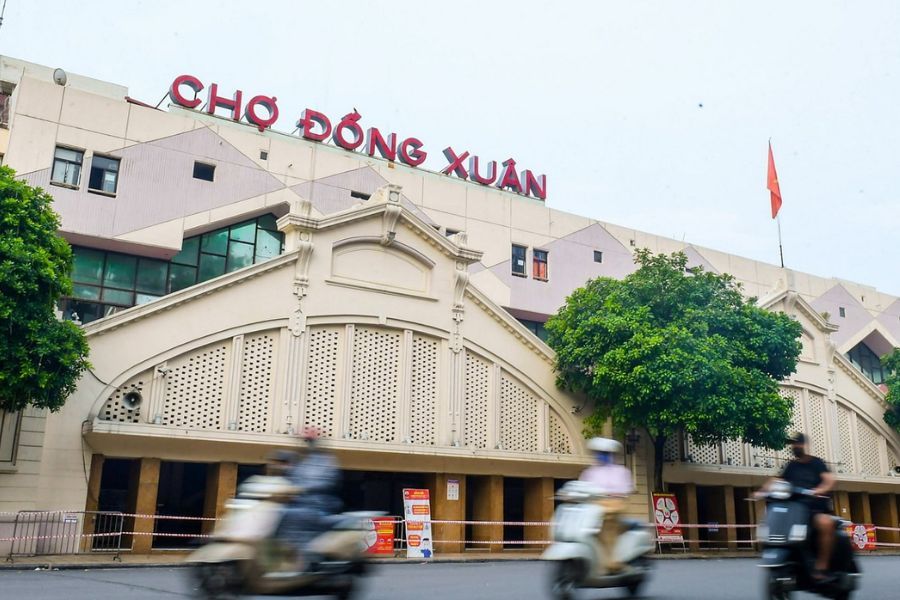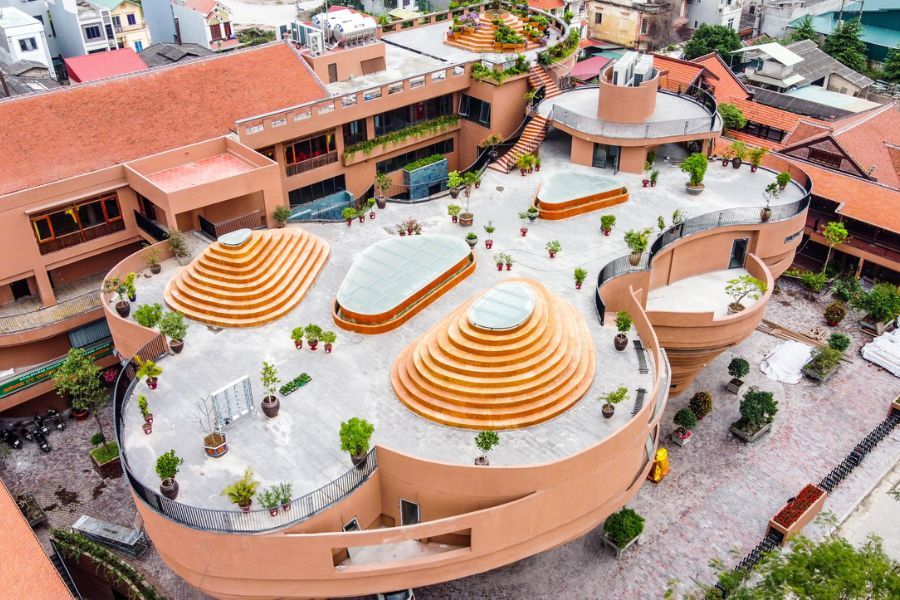Discover Perfume Pagoda: Vietnam’s Spiritual Journey
Perfume Pagoda is a religious site, containing several ancient shrines and temples in the most beautiful grottos. It’s an iconic site attracting pilgrims and visitors all year long. Now, keep following to explore more about this attraction.
Table of Contents
ToggleIntroduction To Perfume Pagoda
The Perfume Pagoda is a vast complex of Buddhist temples and shrines built into the limestone Huong Tich mountains. It’s located in Hanoi, about 50 kilometers southwest of the city, making it a perfect addition to your Hanoi itinerary. It’s also a complex of caves and man-made edifices, and they are consistent with limestone caves and forest as well. One of the holy lands in Vietnam attracts many pilgrims annually. Visitors head here to experience profound spiritual awakenings, discover stunning natural beauty, and connect with centuries-old Vietnamese cultural heritage and religious traditions.
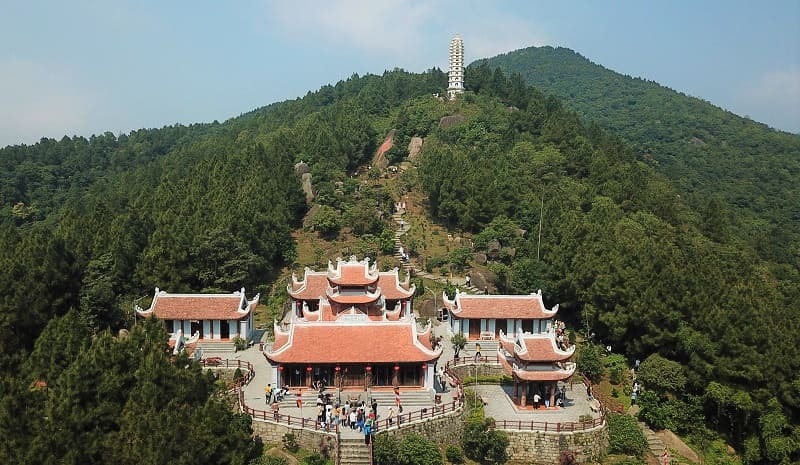
History Of Perfume Pagoda
According to the historical sources and folk legend, this place was discovered by a Buddhist monk in the 15th century. The monk found himself enchanted by the lovely, tranquil limestone mountains and caves. He also thought the site had spiritual power and religious significance. Upon discovering the principal cave, the monk maintained a small shrine within it, where he practiced meditation and performed Buddhist ceremonies. In the succeeding centuries, the area was increasingly turned into a complete religious complex.
The most famous site in the complex is Huong Tich Cave, which has been praised for centuries. And the Perfume Pagoda was particularly significant in spring. Thousands of Vietnamese Buddhists flock to the site each year from the sixth day of the first lunar month to the end of the third lunar month. It is called the Perfume Pagoda Festival, dedicated to prayer, rebirth, and good fortune.

Unique Architecture Of Perfume Pagoda
Perfume Pagoda is a huge complex of temples, shrines, towers, and natural caves that traverse the limestone mountains and verdant jungle. Let’s explore the most significant and unique architectural highlights of this sacred destination.
Huong Tich Cave
Huong Tich Cave, which is also called “Inner Pagoda” or “Chua Trong,” is the most hallowed area of the Perfume Pagoda. With its unique location within a huge limestone cave, rather than being built above ground like the usual pagodas. One of the entrances is a grandiose and mysterious affair. You have to descend a flight of ancient stone steps that plunge into the earth.
In the cave, the natural rock formations are left untouched, allowing stalactites and stalagmites to shape themselves as locals believe they bring blessings. Certain formations look like objects like “Gold Tree,” “Silver Tree,” or “Rice Stack” and are thought to symbolize wealth, fertility, and prosperity. Always inside, carefully placed altars with Buddha statues are illuminated by the dim light that fills the chamber as incense smoke twirls softly through the air.
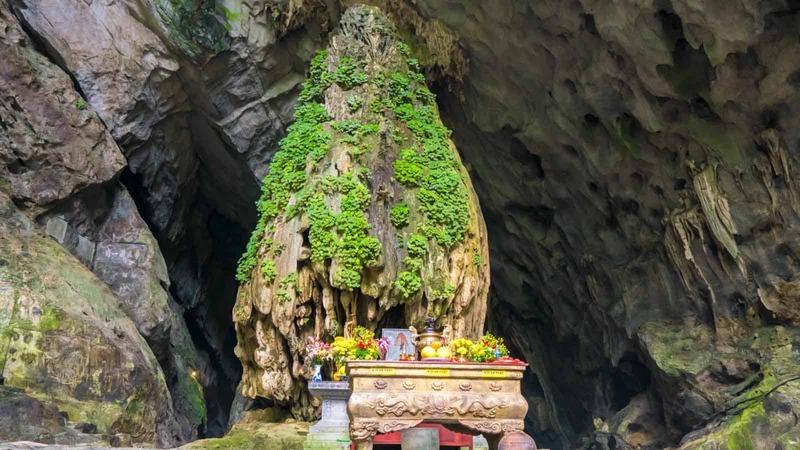
Thien Tru Pagoda
Thien Tru Pagoda, which is also known by the name “Chua Ngoai” or the Outer Pagoda, welcomes visitors at the very entrance of the Perfume Pagoda. The temple was constructed in the 17th century and is a fine example of classical Vietnamese Buddhist architecture. It is characterized by the curved tiled roofs, wooden columns, stone courtyards, and beautifully carved dragons at the roof edges and gates.
The name “Thien Tru” translates as “Heaven Kitchen,” representing the concept of spiritual nutrition. The main worship hall is large and quiet, its statues of the Buddha carefully interspersed among incense burners, flower vases, and traditional offerings. The garden has nearly as many bonsai trees and little stone sculptures as the property itself, giving the feeling of a well-tended, tranquil place.

Giai Oan Temple
A local commune temple on the way between Thien Tru Temple and the cave, called Giai Oan Temple, literally the “Temple of Redemption” or “Purification”, is a base for praying for visiting any kind of grotto. It remains silent by a clear stream, where pilgrims often pause to wash their hands or face as a symbolic cleansing of the spirit before ascending to the main pagoda.
From the architectural perspective, Giai Oan Temple is a simple temple with a stone tile roof, stone steps, and a little arch bridge over the stream. Inside, there are altars to Bodhisattvas and guardians for visitors to reflect and say silent prayers. It serves as a reminder to relinquish their fears, clear their thoughts, and open their hearts before they lace up and continue their ascent up the mountain.

Stone Steps And Mountain Trails
A large part of Perfume Pagoda’s architecture is not in the buildings but in its well-appointed mountain paths and stone staircases. They are crucial to link the various parts of the complex, from the river dock up to the mountain caves.
There are more than 1,200 stone steps leading from Thien Tru Pagoda to Huong Tich Cave. Each leg is chiseled into the mountain, weaving through dense woods, shady glades, and views of valleys, including Rockport Reservoir. Pilgrims along the road pass small shrines, rest areas, and rocks that are believed to have lucky or holy properties.
5 Cultural Experiences You Shouldn’t Miss
A trip to Perfume Pagoda is also about soaking up local spiritual culture. If a peaceful boat rides on the river or solemn rituals are held in the mountain caves, each one embodies the traditions of centuries past. Here are the most significant and most memorable cultural activities included in the Perfume Pagoda itinerary that you should not overlook:
Take A Scenic Boat Ride
The boat trip is the best part of the Perfume Pagoda experience. You will then proceed to go to Yen Stream in a small bamboo boat. You can explore the tranquil backwaters in small metal or wooden boats, sometimes rowed by local women, which ferry you along winding waterways flanked by green rice fields and karst limestone mountains.
The ride lasts 45 to 60 minutes, depending on the season and water levels. Along your way, you’ll also see temples, caves, and blossoming lotus ponds in the spring. With the soft motion of the boat and the tranquil landscapes, you get into a serene, meditative mood, which is a good way to start a spiritual journey.

Attend The Annual Perfume Pagoda Festival
If you come to Perfume Pagoda from late January to early April (Lunar Calendar), you will witness the Perfume Pagoda Festival, one of the largest Buddhist festivals in Vietnam. During this time, thousands of pilgrims come to the Perfume Pagoda to pray for good luck and happiness.
The festival includes folk music, food stalls, vegetarian food, and multicolored paper lanterns hanging from trees. At this time, the area becomes a lively gathering of worship, celebration, and community.
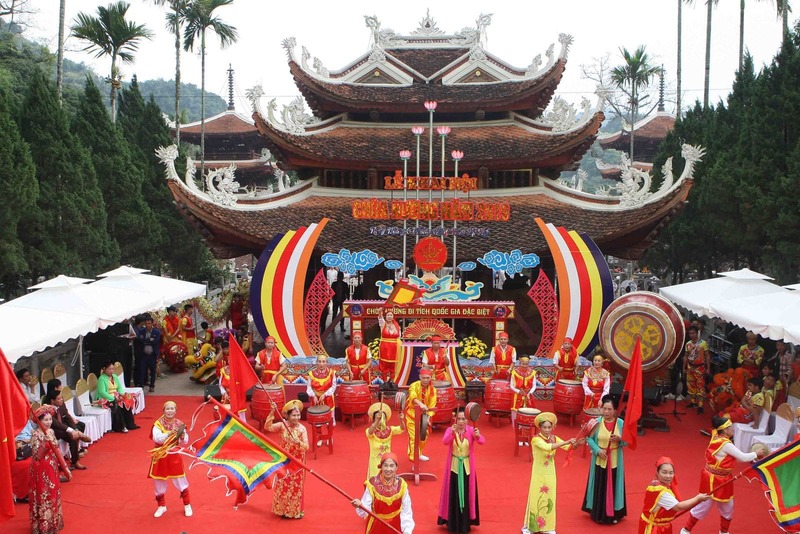
Try The Gondola System
As it remains largely unspoiled and maintains its natural beauty and historical value, Perfume Pagoda is now equipped with a modern gondola. More recently constructed, the gondola aids tourists, particularly the elderly, children, or those who are mobility impaired, in arriving at Huong Tich Cave without demanding an uphill walk.
The gondola line begins at the base of Thien Tru Pagoda and ends approximately at the mouth of the cave. All cabins are equipped with big windows offering a great view of the Yen River, rice fields, and the limestone mountains.
Taste Local Dishes In Riverside Villages
Once they have made the spiritual journey, many visitors have a traditional meal at one of the small restaurants near Thien Tru Pagoda or on the riverbank.
Local specialties are Com Lam (bamboo-cooked rice), Mang Chua (sour bamboo shoots), goat hotpot, and a menu with vegetarian dishes made from forest herbs and wild mushrooms. The majority of the ingredients are grown or harvested in the nearby mountains and preserve the taste of fresh and genuine products.

Observe Traditional Pilgrim Practices
As you travel, you will see Vietnamese pilgrims engaging in some distinct rituals, such as bowing three times to an effigy of the Buddha, writing prayer requests, and touching holy rocks that are said to bestow good fortune. Some place small red ribbons around sacred places, or hang bells.
These customs may be strange at first, but they are very significant to the folks in town. Spending the time to watch and respect these traditions gives you a sense of its spiritual significance, for the place of the pagoda isn’t just a tourist attraction; it’s a living place of faith.
Perfume Pagoda Entrance Fee
The total expenses to visit the complex entail a number of components, which include admission fees to the site, the boat ride along the Yen River, and the option to take the cable car service. The prices may change because of the time of year, especially if you go during the festival season.
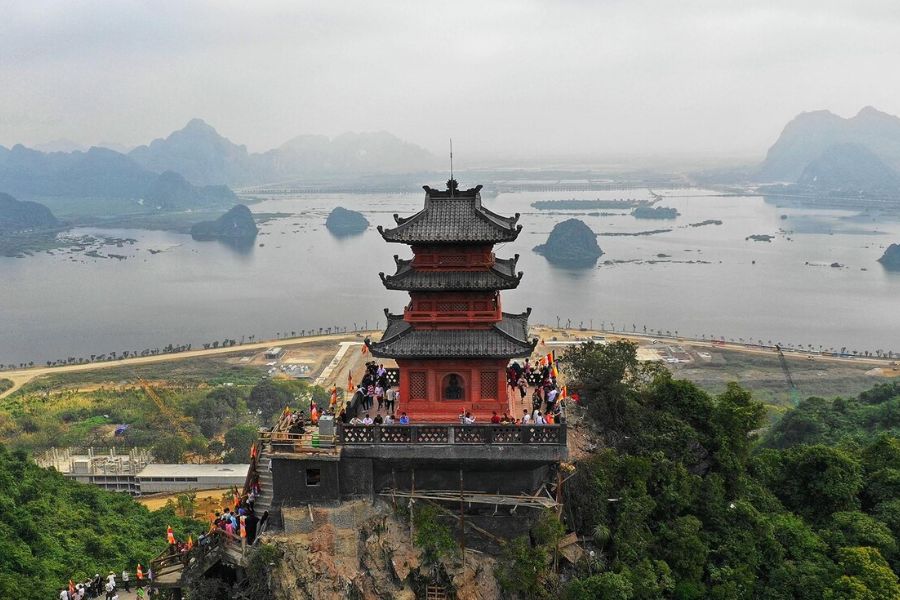
Here are the major fees to be aware of as you plan your budget:
| Type of ticket | Price (VND) | Notes |
| Site entrance fee | 20,000 | Applies to all visitors; grants access to the pagoda complex |
| Boat ride (Round-trip) | 100,000 – 150,000 | Required for traveling along the Yến River to the pagoda base |
| Cable car (One-way) | 100,000 | Optional; for a one-way trip to or from Huong Tich Cave |
| Cable car (Round-trip) | 160,000 – 200,000 | Recommended for round-trip travel without climbing |
| Shrine donations (Optional) | 10,000 – 20,000 | For certain smaller temples or rituals, donation-based |
Opening Hours
The Perfume Pagoda is usually open from morning to late afternoon, from 7 AM to 5 PM daily.
The best time to go is the dry season, from October to April. The weather is cooler, which is better for walking and hiking, and this period often coincides with the best times to visit Hanoi generally.
But the Perfume Pagoda is most crowded during the Perfume Festival, which lasts from the 6th day of the 1st lunar month through the end of the 3rd lunar month. This makes for a culturally vibrant time to visit, but it also means the number of visitors increases.
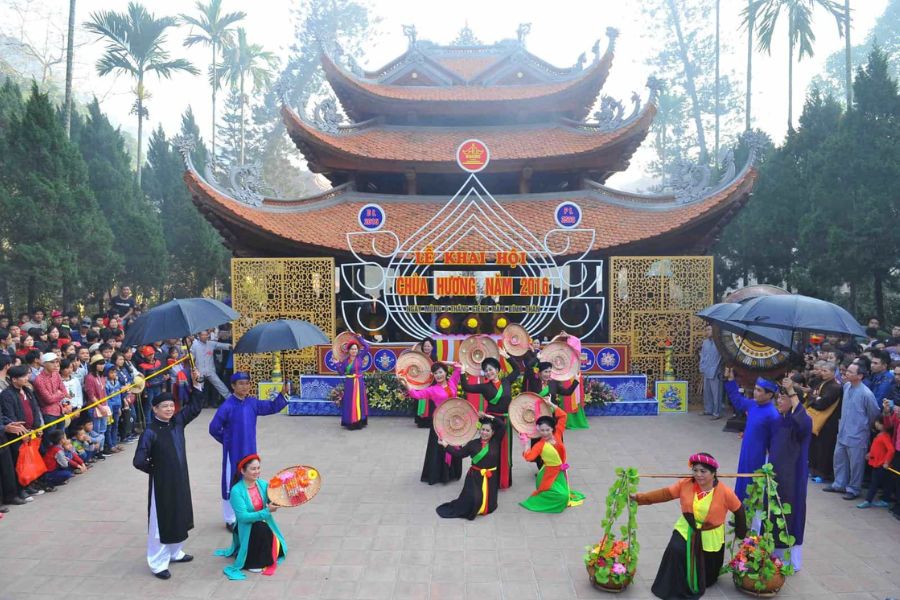
How To Get To Perfume Pagoda
Perfume Pagoda is about 60 kilometers southwest of Hanoi, so there are many types of transport that you can choose to reach there. Here are common ways:
| Transportation method | Cost (One Way) | Travel time | Notes |
| Private Car/taxi | 800,000 – 1,200,000 VND | 1.5 – 2 hours | Most comfortable and direct. The price depends on the car type and negotiation. |
| Local Bus (Public bus) | 30,000 – 50,000 VND | 2 – 2.5 hours | Bus No. 75 from My Dinh Bus Station in Hanoi to Huong Son. |
| Motorbike | 150,000 – 200,000 VND | 1.5 – 2 hours | For experienced riders. Be aware of traffic and road conditions. |
| Organized tour | 600,000 – 1,000,000 VND | Full Day | Includes transportation, guide, boat fees, and sometimes lunch. Check with tour operators. |
Things To Know Before Traveling To Perfume Pagoda
To make your trip to the Perfume Pagoda as straightforward, enjoyable, and respectful as possible, there are a couple of things worth knowing before you get there. Remembering these critical tips will help you get the most out of your spiritual journey, without any surprises or pitfalls:
- Perfume Pagoda is a religious site, and dressing modestly with clothes that cover your shoulders and knees is polite.
- There will be lots of walking and a bit of hiking. Wear comfortable shoes as the paths are uneven, uphill, and downhill.
- If you come during the festival season (January to April), the crowds will be massive.
- Even if some accept cards, make sure to have enough VND currency for the entrance and boat fees, as well as for food and fun.
- The local customs and religion should be accepted and respected by the visitor. For instance, take your shoes off when you visit temples.
- For those who don’t prefer to go hiking, there is a cable car to bring you up and down to Huong Tich Cave.
- If you are opting to tour in an organized manner, last-minute bookings are not that easy, especially in the high season.
Final Thoughts: Is Perfume Pagoda Worth Visiting?
Perfume Pagoda is a stunning mixture of faith, a distinctive cave, and mountain scenery. Is there a better place to find enlightenment or get some great photographs? It’s a tranquil, culturally rich getaway from the city that never sleeps. If you’re looking for more things to do in Hanoi, this spiritual journey offers a unique contrast. Let’s embark on a magical voyage. SeniWorld could take you to the discovery of Perfume Pagoda, with memorable experiences.










